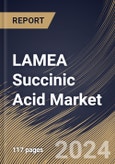Succinic acid production depends on the availability and cost of raw materials, such as glucose, starch, and molasses. Changes in raw material costs can impact the overall cost of succinic acid production, influencing market dynamics. Stringent environmental sustainability and product safety regulations significantly impact the market. Market players must comply with regulatory standards to ensure product acceptance and market access. Economic conditions and market trends influence the adoption of succinic acid in various industries. Factors such as GDP growth, consumer spending patterns, and overall market stability can affect the demand for succinic acid.
The market is characterized by key players competing for market share. Strategies like mergers and acquisitions, product inventions, and strategic partnerships are crucial in shaping the competitive landscape. Continuous advancements in production technologies, including bio-based processes and green chemistry, directly impact the market. Innovations in fermentation techniques and downstream processing contribute to increased efficiency and reduced environmental impact.
As South Africa invests in infrastructure development, it may find applications in construction materials, adhesives, and coatings used in building projects. Its corrosion inhibition properties make it valuable for applications in water treatment. As industries in South Africa focus on efficient water usage, it can play a role in corrosion prevention. The increasing demand for plastic products in South Africa, particularly in construction and packaging, enhances the market potential for succinic acid. Thus, the above aspects will expand the market growth across the region in the upcoming years.
The Brazil market dominated the LAMEA Succinic Acid Market by Country in 2022, and would continue to be a dominant market till 2030; thereby, achieving a market value of $11,895 Thousands by 2030. The Argentina market is showcasing a CAGR of 12.6% during (2023 - 2030). Additionally, The UAE market would register a CAGR of 11.7% during (2023 - 2030).
Based on Type, the market is segmented into Petro-based, and Bio-based. Based on End-use, the market is segmented into Industrial, Food & Beverages, Coatings, Pharmaceutical, Personal Care & Cosmetics, and Others. Based on countries, the market is segmented into Brazil, Argentina, UAE, Saudi Arabia, South Africa, Nigeria, and Rest of LAMEA.
List of Key Companies Profiled
- BASF SE
- Parchem – Fine & Specialty Chemicals
- The Dow Chemical Company
- Mitsubishi Chemical Holdings Corporation
- Nippon Shokubai Co., Ltd.
- Roquette Freres SA
- Spectrum Chemical Mfg. Corp (Spectrum Laboratory Products, Inc.)
- The Chemical Company
- Ernesto Ventos S.A.
- Anhui Sunsing Chemicals Co., Ltd.
Market Report Segmentation
By Type (Volume, Tonnes, USD Million, 2019-2030)- Petro-based
- Bio-based
- Industrial
- Food & Beverages
- Coatings
- Pharmaceutical
- Personal Care & Cosmetics
- Others
- Brazil
- Argentina
- UAE
- Saudi Arabia
- South Africa
- Nigeria
- Rest of LAMEA
Table of Contents
Companies Mentioned
- BASF SE
- Parchem – Fine & Specialty Chemicals
- The Dow Chemical Company
- Mitsubishi Chemical Holdings Corporation
- Nippon Shokubai Co., Ltd.
- Roquette Freres SA
- Spectrum Chemical Mfg. Corp (Spectrum Laboratory Products, Inc.)
- The Chemical Company
- Ernesto Ventos S.A.
- Anhui Sunsing Chemicals Co., Ltd.
Methodology

LOADING...








